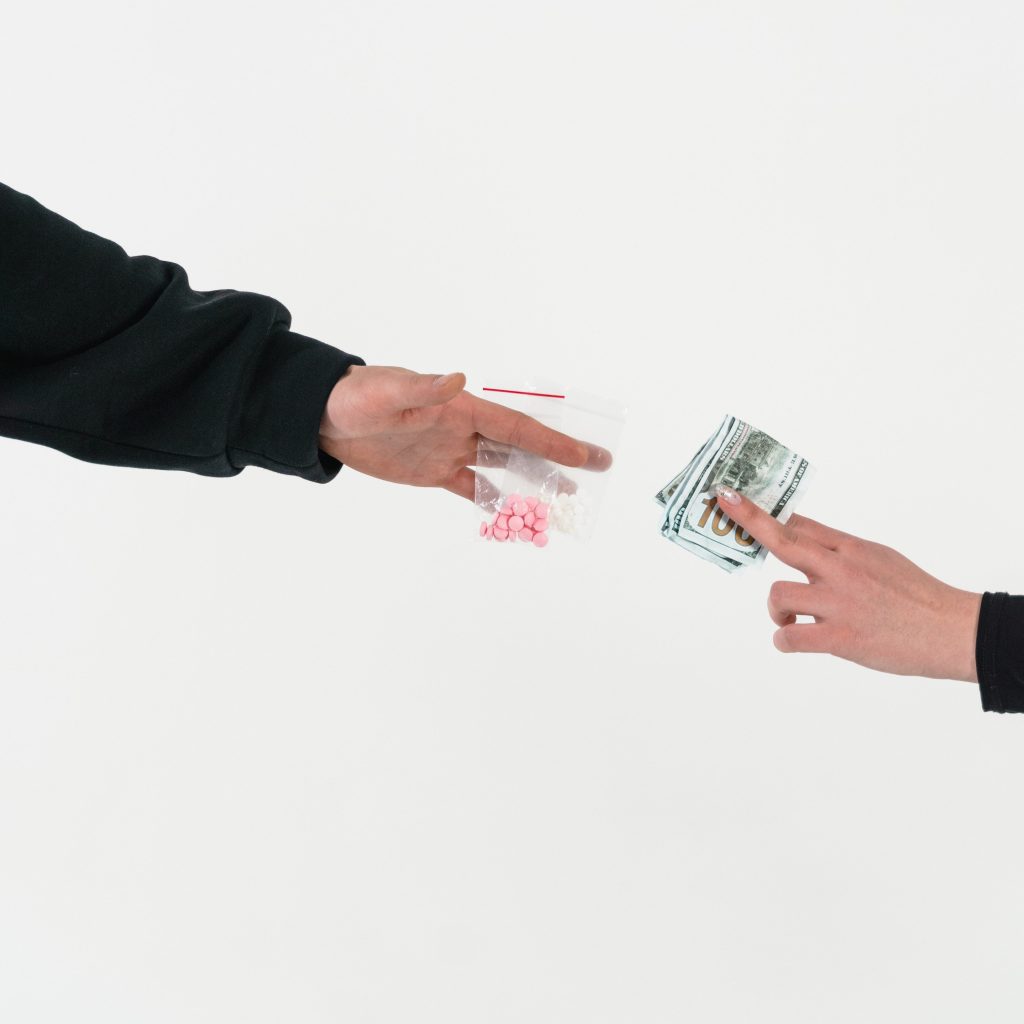Whether we should legalise drugs is a controversial issue. After all, every nation has their own beliefs about drug use. Some substances are culturally embedded, while others provoke moral panic. As such, laws surrounding drug use vary by nation.
Most justifications for restricting drug use stem from concerns about health impacts. However, these laws can have significant social and economic impacts. Thus, it is important to examine and compare the outcomes of these different drug laws.
How does legalising drugs relate to sustainability?
The United Nations created 17 Sustainable Development Goals (SDGs) to benefit humanity. These goals incorporate economic, social, and environmental sustainability. The idea is for all countries to achieve them by 2030. SDG3 is Good Health and Well Being and has seven associated targets. Target 3.5 is to “strengthen the prevention and treatment of substance abuse“. This includes alcohol as well as narcotic drugs.
To achieve this goal, most countries have laws or regulations to control substances. While some countries have strict laws, others are quite lenient towards drug use. This resulted in diverse regulations, treatment programs, and harm reduction policies. The question is, which laws result in the best outcomes? SDG3 is an appropriate benchmark to compare outcomes.
What makes a drug illegal?
The criteria used to classify a drug as illegal also varies across countries. Most countries define drugs as substances which have psychoactive effects on humans. These are classified either by chemical makeup or the type of affect they have on humans. Four common classes are: stimulants, depressants, narcotics, and hallucinogens.

Some controlled substances can be found in nature, like marijuana or cocaine. Others are created synthetically, like amphetamines.
Many illicit drugs are only illegal when taken for recreational purposes. Doctors prescribe drugs in smaller quantities, or controlled doses, as medicine. For example, many painkillers are opioids. In the United States, most illegal drugs are also controlled substances. However, not all controlled substances are illegal. Prescription drugs that are illegal when abused include opioids, sedatives, and stimulants.
There are also drugs which are legal to use for recreation. Caffeine, for example, is a popular drug that people can freely access all around the world. Other substances like alcohol, nicotine, and marijuana have different laws, depending on location.
So, why can you drink as much coffee as you want but might go to prison for using cocaine? The stated reasons for controlling access to drugs is as a harm reduction measure. Yet, illegal drugs such as ecstasy, LSD, and mushrooms are less harmful than alcohol, which is legal. Clearly, other factors are at play.
Drug abuse and misuse
That is not to say that concerns about the harm caused by drug use is unfounded. Drug abuse causes all sorts of negative effects, both physical and mental. These affect the individual, those around them, as well as their greater society.
Unfortunately, prejudice against certain substances has limited research on drug safety. In fact, until recently, scientists weren’t permitted to trial LSD as a PTSD treatment. As a result, we have minimal knowledge of the health impacts of some drugs. This makes it difficult to fairly evaluate their potential harm.

Short term effects of drug abuse are similar to the effects acquired after one too many drinks.
These include:
- Changes in appetite
- Insomnia
- Increased heart rate
- Slurred speech
- Changes in cognitive ability
- Temporary euphoria and loss of coordination
Long-term effects of chronic drug use can include:
- Depression
- Anxiety
- Panic disorders
- Increased aggression
- Paranoia
- Hallucinations
Is drug use a victimless crime?
A victimless crime is one that does not harm society. Unfortunately, whether or not drug use is a victimless crime tends to start debates.
Some argue that any harm from drug use affects only the individual user. This perspective considers only the harm to a person’s health. People who take this view often see drug laws as a violation of personal freedoms.
Others argue that buying illicit drugs contributes to a larger problem. Using, dealing, and buying drugs can contribute to a country’s drug epidemic. Further, drug and gang-related incidents kill thousands of non-drug users each year.

It is true that high crime rates coincide with drug trafficking and gangs. Indeed, gangs are the primary source of illegal drugs. As such, many believe drug use causes crime. However, this may be a case of correlation rather than causation.
To determine the truth, we must look to the effects of different drug laws around the world.
Drug laws by Nation
Countries with harsh drug laws
Places with harsh drug laws have significant penalties for drug possession. These range from extended time in prison to the death penalty.
A list of countries with the harshest drug laws includes:
- Malaysia
- China
- Vietnam
- Iran
- Thailand
- Dubai
- Saudi Arabia
- Singapore
- Cambodia
- Indonesia
- Laos
- North Korea
- the Philippines
- Turkey
- Costa Rica
- Columbia
These strict drug laws don’t seem to reduce drug abuse. In fact, China, Iran, and Malaysia rank in the top six drug addiction rates in the world. These countries also have poor drug addiction treatment and solution policies.
Countries that decriminalise drug use
Although some countries have less strict drug policies, they do not legalise drugs. Even the most lenient countries only decriminalise hard drugs for personal use.
Countries that have decriminalized drugs are:
- Portugal
- Switzerland
- Czech Republic
- the Netherlands
Examining the data from these countries shows the positive results of these policies. Decriminalising drugs does not significantly increase drug use, drug-related harm, or crime. This is when compared to countries that inflict more serious punishments. In fact, Czech Republic found that stricter laws had no impact on the availability of drugs.
The United Nations track the progress of decreasing drug abuse through studies. They most recently published the 2021 Global Overview: Drug Demand and Supply. In it, they estimated how many people used drugs in 2018. They used those figures to predict the number of drug users in 2030, based on population growth. The figure below shows the results. They predict that nearly all continents will see the number of drug users grow by 2 million people. The only exception is Europe – which is expected to see a decrease of 3 million drug users. Notably, multiple European countries have the most flexible drug laws.

Case study: Portugal
Decriminalisation worked well for Portugal. In the 80’s and 90’s, Portugal had some of the highest rates of drug use. Out of desperation, the country decriminalised substances in 2001. Since then, drug-related deaths in Portugal have lowered to 4 deaths per million. This is significantly lower than the European average of 22 deaths per million.
Some believe decriminalisation reduced the stigma associated with drug addicts in Portugal. In fact, decriminalisation has allowed for treatment, and educational programs. It’s important to note that Portugal has not legalised drugs. A person may carry only a small quantity of drugs on their person. However, the penalties for exceeding those quantities are much softer. Such penalties might include paying a fine or attending an educational, harm-reductional intervention. If the user suffers from addiction, they are referred to a harm-reduction intervention. This intervention is based on their specific situation. This has seen a dramatic increase of addicts seeking treatment and no increase in drug use.
Should alcohol be illegal?
Studies have found alcohol is the most harmful drug. So why is it legal in so many countries? In the 1920’s, America famously outlawed alcohol in what is now known as the prohibition. The intent was to reduce the harm caused by alcohol abuse. This included:
- Reducing crime and corruption
- Solving social problems
- Reducing the tax burden created by prisons and poorhouses
- Improving health and hygiene

Due to a high demand in alcohol, the opposite was achieved in terms of crime and corruption. The prohibition of alcohol lead to speakeasys, and a rise in mafia. However, prohibition did lead to a dramatic decrease in alcohol consumption per capita. In fact, this reduction continued uninterrupted long past 1933 (when the prohibition ended). This incident does highlight some disparity between the legal status of different substances. If lawmakers made unbiased decisions based on health risks, alcohol would be illegal. Furthermore, marijuana would likely be legal. Even more damning, increased crime is the reason prohibition was repealed. And yet, high crime rates are used to justify banning other drugs.
Cultural traditions change our perception of drugs
In fact, most drug laws are based on history and culture. Culture determines our attitudes towards which drugs are acceptable to use. For example, in parts of Mexico and the U.S, people have a history of using the drug peyote. For this reason, legislation permits using peyote for religious purposes. Another example of differing cultural norms affecting laws occurs with alcohol. Due to religious prohibition, alcohol is illegal in some Islamic countries.
Media representation can also influence cultural attitudes towards drugs. For instance, there is no chemical difference between “crack” cocaine and its powder form. However, there is a difference in the typical users of these different forms of cocaine. This difference in perception leads to extremely unequal penalties for using what is essentially the same drug.
What’s the difference between legalised drug use and decriminalisation?
Decriminalising drug use allows for medical interventions, instead of punitive measures. Evidence-based treatments can thus reduce problematic behaviours stemming from addiction. This does mean that it is still unlawful to use drugs. Furthermore, selling and manufacturing drugs still carry criminal penalties under this model.
In contrast, legalising drugs would allow for an open and regulated drug market. This has the benefit of providing greater freedom and ensuring safety standards. However, some drugs pose significant health risks in any quantity. Thus, the decriminalised model offers a compromise.
Some people in Portugal believe that decriminalisation still looks down on drug use. This is true in that the stated goal of the policy is to reduce drug use. This is due to the belief that drug use is not a victimless crime as it carries social consequences. Portugal police fear that legalising drugs would encourage further drug use. Instead, the aim is to reduce the harms of drug misuse while improving public safety and health. This is better achieved under a decriminalised model.
So, should we legalise drugs?
SDG 3.5 aims to strengthen the prevention and treatment of substance abuse. Differing cultural practices causes mismatched perception of what counts as drug abuse. As a result, drug laws and punishments vary around the world. Many drugs remain in popular demand despite harsh punishments. Decriminalisation offers a means to effectively reduce the harmful impact of substance abuse. Portugal is one country that has successfully decriminalised drug use. This has consistently lowered their drug addiction and mortality rates.
There is a lot to consider when legalizing or decriminalizing drugs. Cultural perceptions influence which substances people think of as drugs. We must also take into account religious practices which use certain drugs.
To THRIVE, we must achieve target 3.5 of the UN’s SDGs. We can best achieve this through a combined approach. To be just, drug laws should be reviewed and based upon health impacts rather than cultural bias. Unsafe drug use should be decriminalised, and medical intervention offered.
Want to make a difference? You can help the world THRIVE. Contact your local representative to push for fairer drug laws in your country. Or share this article to your friends and family, to help educate the world. Together, we can make a difference.
























My time and experience here, although hindered by the virus lockdown,
was an absolute joy. The Management, therapists, and support staff were incredibly caring
and knowledgeable. I leave feeling stronger, more prepared, and that I have been lovingly looked after and helped on my way.
Thank you once again.